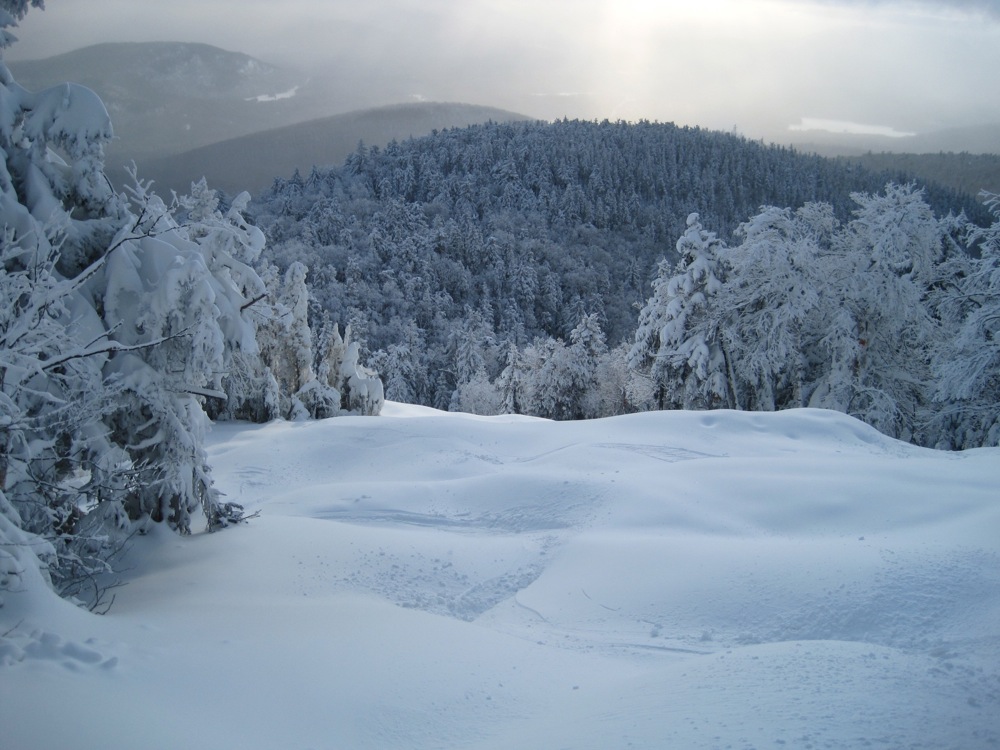In the spring of 2007, I started skiing with a camera. The next summer, I realized how enjoyable it is to look back at photos from the winter, and since 2008, I’ve carried a camera whenever I’m out on snow.
I’ve always considered myself a skier, with a camera, as opposed to a photographer on skis. My primary goal has always been skiing, with photography serving to enhance the experience and memories.
But this year there’s been a shift in my thinking. Especially when I’m skiing alone. I’m starting to see skiing and photography as an integrated activity seeking out images — sometimes to the point of interrupting a great string of turns to pull up and capture the moment. A few times, like in the photo above, I’ve relinquished first tracks to capture a shot. It’s not unusual for me to take 150 pictures in a day.


I might be getting a decent camera soon, so I might need a couple of lessons on settings, shots, and style. Maybe this weekend!
A nice DSLR has been on the top of my want list for about 3 years now, I just never have enough money to spend on one.
Then my problem becomes what to do with it. They’re great for some things, but they’re just too big to ski and bike with.
When you say “150 photos a day,” is that 150 isolated shots or does that number include the times you put the shutter on the “continuous” setting?
150 pics… even with a digital, that is a lot. Summary of my last ski days with a camera:
Saturday: 1 or 2 – from the parking lot.
Sunday: 2 – of my daughter from inside the lodge and one from the town neighbouring the hill. Like I powder day, I don’t bother taking pictures when it’s -29c.
Tuesday: didn’t bother bringing the camera to MRG, I have a bunch of pictures from the place.
Skiing with a camera is a challenge and a hassle. I am a photographer and a skier. I find that when I’m skiing, I really want to ski. To those who mentioned DSLRs – they’re great, but leave them home unless you want to dedicate part of your day to photography. They’re too big and bulky. A pocketable camera is fine and can produce excellent results if you select a good quality camera. Honestly, I’ve taken some very well composed photos with my iPhone4 lately. On a powder day, it’s difficult to resist the urge to “just ski.”
I do use the continuous shutter feature, and at times take as many as 20 frames at once. One day I did that 6 or 7 times — I took about 220 pictures that day. Usually those 150 images are actually about 20-30 shots, with different exposure, framing or zoom. I find it’s really hard to keep steady with bare hands in the cold. Probably 10-15% of my shots are out of focus. Also I now use the LED screen for framing, and with goggles, it’s not an exact science.
Now that I wrote it all down, it does sound like a pain, but I really like looking at the pics later. In total I’d be surprised if the whole day of picture taking took more than 15 minutes. But it does require stopping. On teles, that works out ok for me.
Over the last half dozen years I’ve taken a fair number of photos (25-75) every day out, always using cheap digital cameras. Lots of crummy shots, but maybe one or two keepers a day. I have new $69 Cannon Coolpix cam this year with fairly high res, but I too not fan of LED screen and miss the view finder of older cam. Also, miss quick start-up speed of my older cheap digital camera.
Many of my best shots are highly impromptu and I have only a few seconds to whip out camera from vest pocket and snap a great skier or scene that soon passes from view. Also, it is sometimes surprising to see what you can get out of an initially uninteresting photo after you’ve doctored it with just the standard Microsoft Office picture manager.
A couple of pointers or clarifications for newer photographers. For skiing, a small camera with image stabilization is the ideal in size and function. I find the Canon SD1000is (or the current successor) to work great. Panasonic makes some excellent cameras that run as “point and shoot”, but offer advanced features as well. Many of the Panasonics are co-designed with Leica and use Leica optics for excellent quality. In the sunlight the LCD display can be a real challenge. Polarized goggles make the LCD display virtually useless, but many small digital cameras have a viewfinder that approximates the photo you will get. This along with some minimal editing software can yield very good photos.